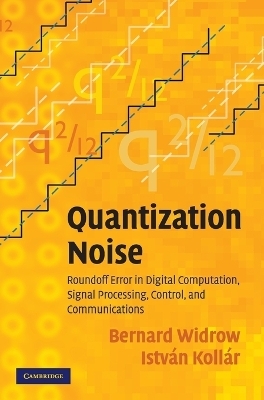
Quantization Noise
Cambridge University Press (Verlag)
978-0-521-88671-0 (ISBN)
If you are working in digital signal processing, control or numerical analysis, you will find this authoritative analysis of quantization noise (roundoff error) invaluable. Do you know where the theory of quantization noise comes from, and under what circumstances it is true? Get answers to these and other important practical questions from expert authors, including the founder of the field and formulator of the theory of quantization noise, Bernard Widrow. The authors describe and analyze uniform quantization, floating-point quantization, and their applications in detail. Key features include: • Analysis of floating point round off • Dither techniques and implementation issues analyzed • Offers heuristic explanations along with rigorous proofs, making it easy to understand 'why' before the mathematical proof is given.
Bernard Widrow, an internationally-recognised authority in the field of quantization, is a Professor of Electrical Engineering at Stanford University, California. He pioneered the field and one of his papers on the topic is the standard reference. He is a Fellow of the IEEE and the AAAS, a member of the US National Academy of Engineering, and the winner of numerous prestigious awards. István Kollár is a Professor of Electrical Engineering at the Budapest University of Technology and Economics, Hungary. A Fellow of the IEEE, he is the recipient of numerous awards, the author of many publications and has been involved in several Industrial Development Projects.
Preface; Glossary of symbols; Acronyms and abbreviations; Part I. Background: 1. Introduction; 2. Sampling theory; 3. Probability density functions, characteristic functions, and moments; Part II. Uniform Quantization: 4. Statistical analysis of the quantizer output; 5. Statistical analysis of the quantization noise; 6. Crosscorrelations between quantization noise, quantizer input, and quantizer Output; 7. General statistical relations among the quantization noise, the quantizer input, and the quantizer output; 8. Quantization of two or more variables - statistical analysis of the quantizer; 9. Quantization of two or more variables - statistical analysis of quantization noise; 10. Quantization of two or more variables - general statistical relations between the quantization noises, and the quantizer inputs and outputs; 11. Calculation of the moments and correlation functions of quantized Gaussian variables; Part III. Floating-point Quantization: 12. Floating-point quantization; 13. More on floating-point quantization; 14. Cascades of fixed-point and floating-point quantizers; Part IV. Quantization in Signal Processing, Feedback Control, and Computations: 15. Roundoff noise in FIR digital filters and in FFT calculations; 16. Roundoff noise in IIR digital filters; 17. Roundoff noise in digital feedback control systems; 18. Roundoff errors in nonlinear dynamic systems - a chaotic example; Part V. Applications of Quantization Noise Theory: 19. Dither; 20. Spectrum of quantization noise and conditions of whiteness; Part VI.Quantization of system parameters; 21. Coefficient quantization; Appendices: A. Perfectly bandlimited characteristic functions; B. General expressions of the moments of the quantizer output, and of the errors of Sheppard's Corrections; C. Derivatives of the sinc function; D. Proofs of quantizing theorems III and IV; E. Limits of applicability of the theory - Caveat reader; F. Some properties of the Gaussian PDF and CF; G. Quantization of a sinusoidal input; H. Application of the methods of appendix G to distributions other than sinusoidal; I. A Few properties of selected distributions; J. Digital dither; K. Roundoff noise in scientific computations; L. Simulating arbitrary-precision fixed-point and floating-point roundoff in Matlab; M. A Few papers from the literature of quantization theory; Bibliography; Index; Appendices N-V (available online only): N. Comparison of the characteristic function method and Sheppard's approach; O. Interpolation of the cumulative distribution function from the histogram and numerical reconstruction of the Input PDF; P. Small bit-number correlation; Q. Noise shaping and sigma-delta modulation; R. Second-order statistical properties of a triangle-wave signal; S. Characteristic functions of quantities involved when using Dither; T. Kind corrections; U. Comparison of the engineers' Fourier transform and definition of the characteristic function; V. A few more papers from the literature of quantization theory.
| Erscheint lt. Verlag | 3.7.2008 |
|---|---|
| Zusatzinfo | Worked examples or Exercises; 358 Line drawings, unspecified |
| Verlagsort | Cambridge |
| Sprache | englisch |
| Maße | 179 x 254 mm |
| Gewicht | 1660 g |
| Themenwelt | Technik ► Elektrotechnik / Energietechnik |
| Technik ► Nachrichtentechnik | |
| ISBN-10 | 0-521-88671-6 / 0521886716 |
| ISBN-13 | 978-0-521-88671-0 / 9780521886710 |
| Zustand | Neuware |
| Haben Sie eine Frage zum Produkt? |
aus dem Bereich


